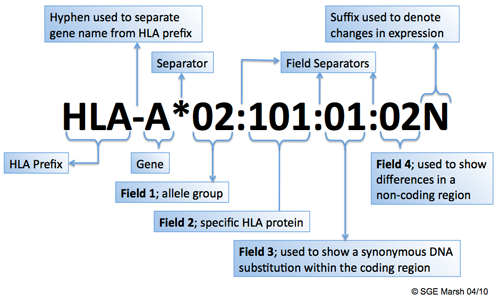Nomenclature for Factors of the HLA System
Nomenclature of HLA Alleles
Each HLA allele name has a unique number corresponding to up to four sets of digits separated by colons. The length of the allele designation is dependent on the sequence of the allele and that of its nearest relative. All alleles receive at least a four digit name, which corresponds to the first two sets of digits, longer names are only assigned when necessary.
The digits before the first colon describe the type, which often corresponds to the serological antigen carried by an allotype. The next set of digits are used to list the subtypes, numbers being assigned in the order in which DNA sequences have been determined. Alleles whose numbers differ in the two sets of digits must differ in one or more nucleotide substitutions that change the amino acid sequence of the encoded protein. Alleles that differ only by synonymous nucleotide substitutions (also called silent or non-coding substitutions) within the coding sequence are distinguished by the use of the third set of digits. Alleles that only differ by sequence polymorphisms in the introns, or in the 5' or 3' untranslated regions that flank the exons and introns, are distinguished by the use of the fourth set of digits.
In addition to the unique allele number, there are additional optional suffixes that may be added to an allele to indicate its expression status. Alleles that have been shown not to be expressed - 'Null' alleles - have been given the suffix 'N'. Alleles that have been shown to be alternatively expressed may have the suffix 'L', 'S', 'C', 'A' or 'Q'.
The suffix 'L' is used to indicate an allele which has been shown to have 'Low' cell surface expression when compared to normal levels. The 'S' suffix is used to denote an allele specifying a protein which is expressed as a soluble, 'Secreted' molecule but is not present on the cell surface. The 'C' suffix is assigned to alleles that produce proteins that are present in the 'Cytoplasm' and not on the cell surface. An 'A' suffix indicates an 'Aberrant' expression where there is some doubt as to whether a protein is actually expressed. A 'Q' suffix is used when the expression of an allele is 'Questionable', given that the mutation seen in the allele has been shown to affect normal expression levels in other alleles.
As of March 2017, no alleles have been named with the 'C' or 'A' suffixes.

| Nomenclature | Indicates |
|---|---|
| HLA | the HLA region and prefix for an HLA gene |
| HLA-DRB1 | a particular HLA locus i.e. DRB1 |
| HLA-DRB1*13 | a group of alleles that encode the DR13 antigen or sequence homology to other DRB1*13 alleles |
| HLA-DRB1*13:01 | a specific HLA allele |
| HLA-DRB1*13:01:02 | an allele that differs by a synonymous mutation from DRB1*13:01:01 |
| HLA-DRB1*13:01:01:02 | an allele which contains a mutation outside the coding region from DRB1*13:01:01:01 |
| HLA-A*24:09N | a 'Null' allele - an allele that is not expressed |
| HLA-A*30:14L | an allele encoding a protein with significantly reduced or 'Low' cell surface expression |
| HLA-A*24:02:01:02L | an allele encoding a protein with significantly reduced or 'Low' cell surface expression, where the mutation is found outside the coding region |
| HLA-B*44:02:01:02S | an allele encoding a protein which is expressed as a 'Secreted' molecule only |
| HLA-A*32:11Q | an allele which has a mutation that has previously been shown to have a significant effect on cell surface expression, but where this has not been confirmed and its expression remains 'Questionable' |
Please follow this link for further details regarding pre-2010 alelle designations. For details of alleles named prior to the most recent Nomenclature Report, please click here. Follow this link for further details of the changes that occurred between the two nomenclature versions and how this was described. For nomenclature conversion tools please see the Conversion Tool at the IPD-IMGT/HLA Database.

